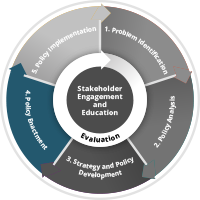
POLICY ENACTMENT
This section provides guidance about communicating policy strategies to address TDV.
While the role of local health departments and other organizations in some policy activities can be limited, they can play an important role in educating decision-makers and stakeholders about available policy options and their potential health impact.
Develop messages that clearly tell your target audiences why TDV is an issue in your community and what they can do to help prevent it. Messages can give the target audience clear actions or activities, describe the outcomes of those actions and cite evidence-based resources.[5]
Whether providing decision-makers with information on the benefits of evidence-based strategies and evaluation, or educating the public on potential policy solutions to stop TDV before it starts, clear communication through the appropriate communication vehicle is important. Consider what type of communication device might best achieve your goal. Potential vehicles for communicating your messages might include a white paper, a data compendium, a presentation, a policy brief, or a news piece.
Use the data about the problem of TDV in your community collected during the Problem Identification phase to prepare a few clear and compelling sentences that can be used as talking points or in written materials. In just a few sentences, your message should explain what you are proposing, why it is worth doing, and the effects of your proposal. You can then adapt these messages to meet the needs of your target audiences and your communication methods.
When communicating with stakeholders, inform your audience of evidence-based and evidence-informed programs. In addition to your community advisory board, potential stakeholders could include various local and state agencies, community-based organizations and institutions that may be affected by your policy work, formal or informal groups, and individual champions.[6]
Your community advisory board and other partners and stakeholders might be able to support policy as part of a comprehensive approach to TDV prevention by using access to media and other communications channels to help convey educational messages to key stakeholders and the public about the nature of TDV in the community and evidence-based strategies for preventing TDV and supporting healthy relationships.
This Guide and website are provided for informational purposes only. Note that certain restrictions apply to the use of CDC funds for impermissible lobbying. For more information concerning such restrictions see the CDC Anti-Lobbying Guidelines.

